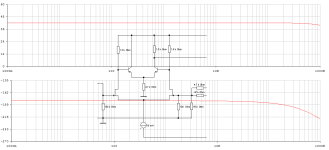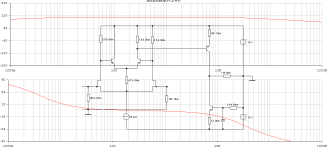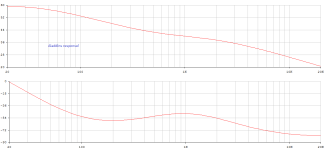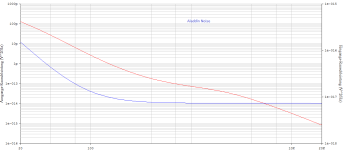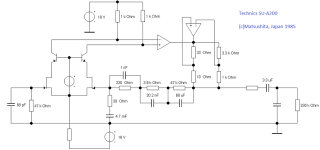Aladdin, the genie in the bottle
If we also want to consider the Nick EQ as two-stage, then allow me to make comparisons and an analysis.
The open loop shows us that the second stage must also amplify very highly. There must be at least another +40dB. So that the topology and dimensioning appear fundamentally suitable for an AllInOne equalization.
If we also want to consider the Nick EQ as two-stage, then allow me to make comparisons and an analysis.
The open loop shows us that the second stage must also amplify very highly. There must be at least another +40dB. So that the topology and dimensioning appear fundamentally suitable for an AllInOne equalization.
Attachments
Aladdin meets Sukhov
Will this work, even without an additional OP amp to offset compensate the circuit? Perhaps an evolutionary step of the OREAD germ cell is possible?
The idle (OPL) gain already fits! The bipolar shot noise is excluded due to the negative conducting channel ..!
Will this work, even without an additional OP amp to offset compensate the circuit? Perhaps an evolutionary step of the OREAD germ cell is possible?
The idle (OPL) gain already fits! The bipolar shot noise is excluded due to the negative conducting channel ..!
Attachments
AI Aladdin works
Unfortunately, artificial intelligence has thrown away Sukhov's correction network. Apparently, a known standard network is rated higher.
Unoise (1kHz extracted, bandwidth 19980 Hz) 271.4nV
ue = 5mV
ua = 0.5Vrms
This would result in an max SNR of |125 dB|, says the AI - can this really be true?
😉
Unfortunately, artificial intelligence has thrown away Sukhov's correction network. Apparently, a known standard network is rated higher.
Unoise (1kHz extracted, bandwidth 19980 Hz) 271.4nV
ue = 5mV
ua = 0.5Vrms
This would result in an max SNR of |125 dB|, says the AI - can this really be true?
😉
Attachments
Last edited:
Approximation late at night:
271.4nV / sqrt(Hz)
SNR[1k_bw] = 95,31dB
SNR[20k_bw] = 82,30dB
without a real MM-System.
271.4nV / sqrt(Hz)
SNR[1k_bw] = 95,31dB
SNR[20k_bw] = 82,30dB
without a real MM-System.
Last edited:
Here is now the result of the last iteration of the artificial intelligence Aladdin. The starting point was the Nick Sukhov Wonder Equalizer:
If you want to do without any coupling capacitors and a DC servo circuit, you could simply balance the system a little better and make the 15mA constant current source adjustable. Replace the 360Ohm resistor marked in red with a trimmer - and hope for minimal self-heating ..!
The 960 Ohm resistor marked in red is varied until the DC bridge voltage between the two collectors reaches its minimum.
@Chestnutspread,
which circuit do we want to settle on? I think we should now implement OREAD in the original idea /sense, preferably with 19 bipolar transistors and unequally distributed currents.
Kind regards,
HBt.

If you want to do without any coupling capacitors and a DC servo circuit, you could simply balance the system a little better and make the 15mA constant current source adjustable. Replace the 360Ohm resistor marked in red with a trimmer - and hope for minimal self-heating ..!
The 960 Ohm resistor marked in red is varied until the DC bridge voltage between the two collectors reaches its minimum.
@Chestnutspread,
which circuit do we want to settle on? I think we should now implement OREAD in the original idea /sense, preferably with 19 bipolar transistors and unequally distributed currents.
Kind regards,
HBt.
The 5V6 zener in that circuit might be a source of noise - normally zeners get a capacitor across them to reduce noise.
The constant current sink on the input stage has unnecessary duplication. The standing current through the 1N4448 is much higher than it needs to be - that 3k resistor could be 33k and the 360 a 3k9 and save about 5mA.
1N4448 is a weird choice, as its a 1N4148 selected for very low reverse leakage, yet its forward biased here and the standard 1N4148 would be fine.
No compensation cap - I wonder if its stable?
[ And the AI can't spell the unit ohm correctly! ]
The constant current sink on the input stage has unnecessary duplication. The standing current through the 1N4448 is much higher than it needs to be - that 3k resistor could be 33k and the 360 a 3k9 and save about 5mA.
1N4448 is a weird choice, as its a 1N4148 selected for very low reverse leakage, yet its forward biased here and the standard 1N4148 would be fine.
No compensation cap - I wonder if its stable?
[ And the AI can't spell the unit ohm correctly! ]
Dear Mark,The 5V6 zener in that circuit might be a source of noise - normally zeners get a capacitor across them to reduce noise.
this is only a basic picture of the topology. I simply assume that the missing rest, such as blocking capacitors and other charging capacitors or RF shorts, are self-evident.
So yes, a 100nF MKT parallel to the Z-diode is missing - for a construction proposal, but then information on the semiconductors themselves is also missing.
This would be quite possible, other resistance ratios and resulting cross-currents are conceivable - but the doubling is intended and desired.The constant current sink on the input stage has unnecessary duplication. The standing current through the 1N4448 is much higher than it needs to be - that 3k resistor could be 33k and the 360 a 3k9 and save about 5mA.
Totally right.1N4448 is a weird choice, as its a 1N4148 selected for very low reverse leakage, yet its forward biased here and the standard 1N4148 would be fine.
AI is not yet that good ;-).No compensation cap - I wonder if its stable?
That's the way it is with the critters, they don't know the Greek alphabet in this context yet - unless we feed it to them ;-).[ And the AI can't spell the unit ohm correctly! ]
Mark,
how do you like the design, which is derived from the great grandmaster Sukhov's? - with slight variations.
Regards,
HBt.
🙂
Last edited:
The unit is called the ohm, not Ohm. The ohm is named after Georg Ohm, but units are not proper names and are not capitalized any more than foot, kilo, ounce or mile are.
As for the design you need to specify which transistors and FETs and find out how well it performs really - I'd worry about the lack of current-mirror load for the input pair, that's usually a simple win with any differential pair.
As for the design you need to specify which transistors and FETs and find out how well it performs really - I'd worry about the lack of current-mirror load for the input pair, that's usually a simple win with any differential pair.
But we don't want to cherry-pick, do we?
Dear Mark,
did you follow the Master's path after completing your Bachelor's degree?
Regards,
HBt.
😉
Dear Mark,
did you follow the Master's path after completing your Bachelor's degree?
Regards,
HBt.
😉
Until you replace the bipolar transistors in the input stage with JFET ones (I recommend JFE2140), the large shot noise of the base current flowing through the almost 1H inductance (or or 10th of kOhms impedance @ mid HF 5 kHz) of the MM cartridge will not allow you to minimize the overall noise (...)
I would like to quote a fellow countryman of mine:
"FETS are a choice for MM cartridge phono-amps. The best ones beat the best BJTs with a tiny advantage."
[Burkhard Vogel, Stuttgart, Deutschland]
You know the Source!
"The Sound of Silence ...", page 62.
HBt.
What is going on with the semiconductor and other components market? You can hardly buy anything anymore!
So how about the oldschool parts, BC109 &BC177 or the 2N2484? Is there a comparable PNP type for the 2N2484?
These three are currently available in germany and the most suitable ones can be determined from a 50 piece bag, let's see if Marcel's concerns about the shot noise can be confirmed or refuted.
@Chestnutspread,
wake up, christmas and all the rest is history 😉.
Now we have to deliver so that this thread doesn't become a zero number - hopefully you haven't dropped off, if you're also from Lower Saxony in Germany.
I'm looking forward to the first measurement and listening with headphones.
Regards,
HBt.
So how about the oldschool parts, BC109 &BC177 or the 2N2484? Is there a comparable PNP type for the 2N2484?
These three are currently available in germany and the most suitable ones can be determined from a 50 piece bag, let's see if Marcel's concerns about the shot noise can be confirmed or refuted.
@Chestnutspread,
wake up, christmas and all the rest is history 😉.
Now we have to deliver so that this thread doesn't become a zero number - hopefully you haven't dropped off, if you're also from Lower Saxony in Germany.
I'm looking forward to the first measurement and listening with headphones.
Regards,
HBt.
The basic circuit could also look like this, our discrete OP amp. would now be a complementary to post #2.
A comparison of the subsequent total noise and other disturbances would also be interesting.

A comparison of the subsequent total noise and other disturbances would also be interesting.
Happy new year! The iron is still cold but the dust is removed. Unfortunately I need to wait a couple days till I receive my parts from the Onlineshop. As soon I have results to share I do so 😉Just by the way
Take a look at what beautiful equalizers the Japanese (not just only Kenwood / TRIO) developed in the 1980s.
Have you already fired up the soldering iron?
Happy New Year dear "Chestnutspread",
HBt.
🙂
The same I faced, no nice parts available or only on dubious shops I've never heard of. That's the reason I already mentioned dual-fet smd parts. The availability is horrible...What is going on with the semiconductor and other components market? You can hardly buy anything anymore!
So how about the oldschool parts, BC109 &BC177 or the 2N2484? Is there a comparable PNP type for the 2N2484?
These three are currently available in germany and the most suitable ones can be determined from a 50 piece bag, let's see if Marcel's concerns about the shot noise can be confirmed or refuted.
@Chestnutspread,
wake up, christmas and all the rest is history 😉.
Now we have to deliver so that this thread doesn't become a zero number - hopefully you haven't dropped off, if you're also from Lower Saxony in Germany.
I'm looking forward to the first measurement and listening with headphones.
Regards,
HBt.
- Home
- Source & Line
- Analogue Source
- Oread - a DIY MM phono approach
